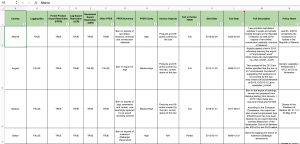FPERs range from comprehensive bans on all raw or crudely processed forest products, to more narrow, partial restrictions targeting certain types of timber, specific tree species, or distinct regions of harvest. In some countries, the wording of the FPER policies may be ambiguous or difficult to interpret. In some cases, government officials can grant exemptions under special circumstances. For this reason, it can be difficult to determine if the import of timber from a FPER country is illegal.
Nevertheless, the presence of a Forest Product Export Restriction (FPER) signals a need for additional risk assessment and mitigation actions to ensure that the import of certain products from these countries does not violate the specific laws and regulations of the source country.[3] In the US, Europe and Australia, regulated market transactions involving products in violation of a FPER policy from the country of harvest are typically within the scope of the US Lacey Act, the European Union Timber Regulation (EUTR) and the Australian Illegal Logging Prohibition Act (ILPA).[4] Despite this, countries continue to import timber from FPER countries, potentially in violation of both the source countries’ and destination countries’ legislation. From 2012 – 2019, the USA imported imported $2.07 billion of sawnwood from countries with sawnwood export restrictions (SERs); the EU + EFTA[5] imported $1.88 billion in logs and $7.08 billion in sawnwood from countries restricting the export of those products; and Australia imported $179.2 million in sawnwood from SER countries.
While this analysis represents the most aggregated and codified database for FPERs to date, much remains unclear for the purposes of the enforcement of legal timber trade. Forest Trends encourages all interested parties to submit any information on Forest Product Export Restrictions to be considered for inclusion in future iterations of the database. For questions or to submit information, please contact Kerstin Canby at Forest Trends ([email protected]).
Forest Trends does not represent or warrant the accuracy, suitability, or content of this catalogue of best known information. It is the sole responsibility and obligation of the reader and user of this list to satisfy himself/herself as to the accuracy, suitability, and content of the information contained herein. Forest Trends (including its respective affiliates, officers, directors, partners, and employees) makes no warranties and shall have no liability to the reader for any inaccuracy, representation, or misrepresentation set out herein. The reader further agrees to hold Forest Trends harmless from and against any claims, loss, or damage in connection with or arising out of any commercial decisions made on the basis of the information contained herein. The reader of this report is strongly advised not to use the content of this report in isolation, but to take the information contained herein together with other market information and to formulate his/ her own views, interpretations, and opinions thereon. The reader is strongly advised to seek appropriate legal and professional advice before entering into commercial transactions.
[1] While most studies have historically applied the term “ban” to refer to these policies, Forest Trends instead applies the term “restrictions” to cover other limitations on exports, including maximum export quotas.
[2] Data was sourced from UN Comtrade and the Chinese General Administration of Customs. For more information on Forest Trends trade analyses, visit https://www.forest-trends.org/fptf-ilat-home/. The last data update was performed in: March 2021
[3] Despite their seeming simplicity, Forest Product Export Restrictions (FPERs) are often difficult to enforce, due to low capacity of government agencies to outright fraud and corruption along the supply chain.
[4] As such, logs as well as finished timber products imported into these markets from manufacturing hubs such as China and Vietnam would also be at risk for legality violations if these products originated as logs, sawnwood or other covered timber products imported into those countries in violation of a FPER.
[5] All references to “EU + EFTA” signify the 28 Member States of the European Union, as well as Iceland, Lichtenstein, Norway and Switzerland.

